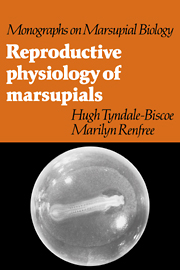Book contents
- Frontmatter
- Contents
- Preface
- 1 Historical introduction
- 2 Breeding biology of marsupials by family
- 3 Sexual differentiation and development
- 4 Male anatomy and spermatogenesis
- 5 The female urogenital tract and oogenesis
- 6 Ovarian function and control
- 7 Pregnancy and parturition
- 8 Lactation
- 9 Neuroendocrine control of seasonal breeding
- 10 Marsupials and the evolution of mammalian reproduction
- References
- Index
6 - Ovarian function and control
Published online by Cambridge University Press: 06 January 2010
- Frontmatter
- Contents
- Preface
- 1 Historical introduction
- 2 Breeding biology of marsupials by family
- 3 Sexual differentiation and development
- 4 Male anatomy and spermatogenesis
- 5 The female urogenital tract and oogenesis
- 6 Ovarian function and control
- 7 Pregnancy and parturition
- 8 Lactation
- 9 Neuroendocrine control of seasonal breeding
- 10 Marsupials and the evolution of mammalian reproduction
- References
- Index
Summary
The growth and development of ovarian follicles has been discussed in Chapter 5. In this Chapter we review the evidence for hormonal secretion and the several functions of the ovary in marsupials, as well as the evidence for endocrine control of the ovary. Because of its profound importance in the regulation of the oestrous cycle and pregnancy of marsupials, consideration of the functions and control of the corpus luteum forms a large part of this Chapter.
Serious study of the corpus luteum of marsupials dates from Sandes' (1903) paper on Dasyurus viverrinus and O'Donoghue's (1912, 1914, 1916) papers on this and nine other species. Sandes concluded that the corpus luteum is probably a gland of internal secretion with the functions of influencing the genital organs and of stopping further ovulation during pregnancy. O'Donoghue (1912) extended these conclusions to the corpus luteum of the non-pregnant female by showing that in its growth and development and in the related changes in the genital tract it was wholly equivalent to the corpus luteum of pregnancy, and this was subsequently shown to hold for almost all other marsupials (Sharman, 1970). During the past decade, the application of hormone-assay and surgical techniques has fully confirmed and extended Sandes' conclusion as to the importance of the corpus luteum in marsupial reproduction. There is now evidence that it is involved in the regulation of follicular growth and ovulation; in oestrous behaviour and, possibly, in male response; in embryo development and endometrial growth and secretion; and in the preparation of the genital tract for parturition and of the mammary gland for lactation.
- Type
- Chapter
- Information
- Reproductive Physiology of Marsupials , pp. 203 - 257Publisher: Cambridge University PressPrint publication year: 1987
- 2
- Cited by



